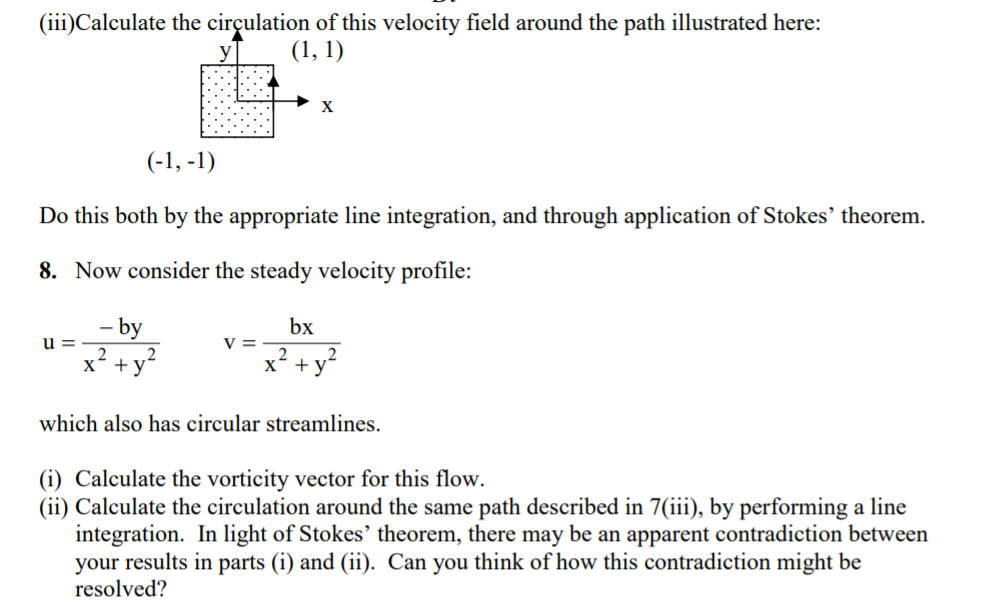-by bx u = v= 2 2 x² + y² x+y which also has circular streamlines. (i) Calculate the vorticity vector for this flow. (ii) Calculate the circulation around the same path described in 7(iii), by performing a line integration. In light of Stokes' theorem, there may be an apparent contradiction between your results in parts (i) and (ii). Can you think of how this contradiction might be resolved?
-by bx u = v= 2 2 x² + y² x+y which also has circular streamlines. (i) Calculate the vorticity vector for this flow. (ii) Calculate the circulation around the same path described in 7(iii), by performing a line integration. In light of Stokes' theorem, there may be an apparent contradiction between your results in parts (i) and (ii). Can you think of how this contradiction might be resolved?
Introduction to Chemical Engineering Thermodynamics
8th Edition
ISBN:9781259696527
Author:J.M. Smith Termodinamica en ingenieria quimica, Hendrick C Van Ness, Michael Abbott, Mark Swihart
Publisher:J.M. Smith Termodinamica en ingenieria quimica, Hendrick C Van Ness, Michael Abbott, Mark Swihart
Chapter1: Introduction
Section: Chapter Questions
Problem 1.1P
Related questions
Question
I want to ask the (2) question in 8. Thank you!

Transcribed Image Text:(iii)Calculate the cirçulation of this velocity field around the path illustrated here:
(1, 1)
X
(-1, -1)
Do this both by the appropriate line integration, and through application of Stokes' theorem.
8. Now consider the steady velocity profile:
by
bx
u =
V =
x +y-
x* + y
which also has circular streamlines.
(i) Calculate the vorticity vector for this flow.
(ii) Calculate the circulation around the same path described in 7(iii), by performing a line
integration. In light of Stokes' theorem, there may be an apparent contradiction between
your results in parts (i) and (ii). Can you think of how this contradiction might be
resolved?
Expert Solution
This question has been solved!
Explore an expertly crafted, step-by-step solution for a thorough understanding of key concepts.
Step by step
Solved in 3 steps with 7 images

Recommended textbooks for you

Introduction to Chemical Engineering Thermodynami…
Chemical Engineering
ISBN:
9781259696527
Author:
J.M. Smith Termodinamica en ingenieria quimica, Hendrick C Van Ness, Michael Abbott, Mark Swihart
Publisher:
McGraw-Hill Education

Elementary Principles of Chemical Processes, Bind…
Chemical Engineering
ISBN:
9781118431221
Author:
Richard M. Felder, Ronald W. Rousseau, Lisa G. Bullard
Publisher:
WILEY

Elements of Chemical Reaction Engineering (5th Ed…
Chemical Engineering
ISBN:
9780133887518
Author:
H. Scott Fogler
Publisher:
Prentice Hall

Introduction to Chemical Engineering Thermodynami…
Chemical Engineering
ISBN:
9781259696527
Author:
J.M. Smith Termodinamica en ingenieria quimica, Hendrick C Van Ness, Michael Abbott, Mark Swihart
Publisher:
McGraw-Hill Education

Elementary Principles of Chemical Processes, Bind…
Chemical Engineering
ISBN:
9781118431221
Author:
Richard M. Felder, Ronald W. Rousseau, Lisa G. Bullard
Publisher:
WILEY

Elements of Chemical Reaction Engineering (5th Ed…
Chemical Engineering
ISBN:
9780133887518
Author:
H. Scott Fogler
Publisher:
Prentice Hall


Industrial Plastics: Theory and Applications
Chemical Engineering
ISBN:
9781285061238
Author:
Lokensgard, Erik
Publisher:
Delmar Cengage Learning

Unit Operations of Chemical Engineering
Chemical Engineering
ISBN:
9780072848236
Author:
Warren McCabe, Julian C. Smith, Peter Harriott
Publisher:
McGraw-Hill Companies, The